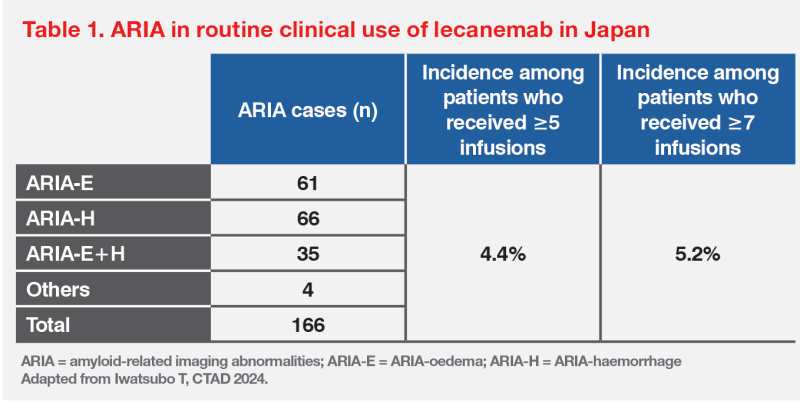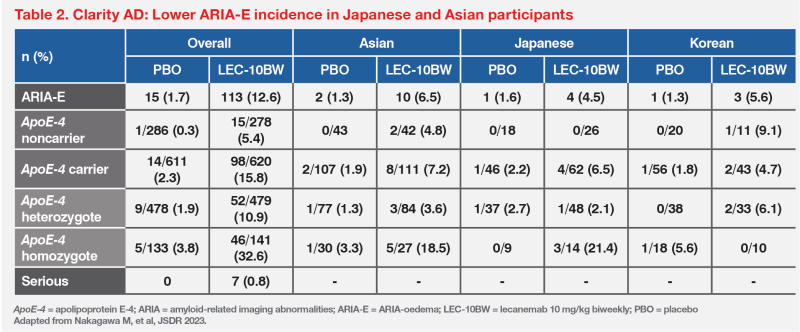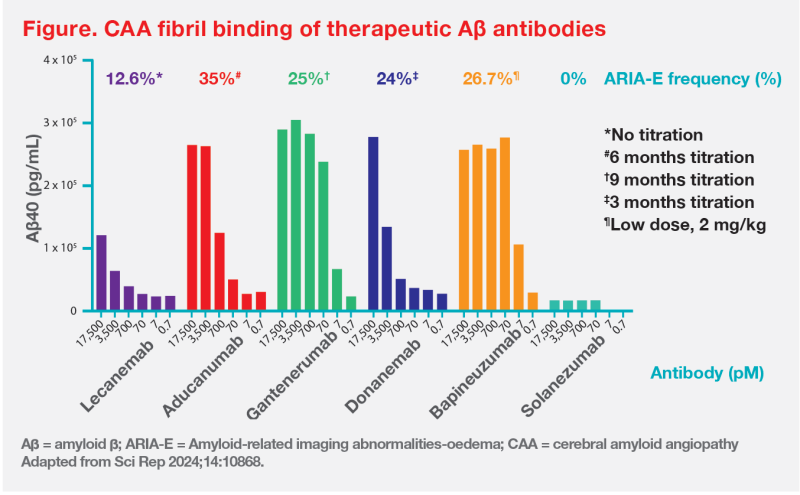CTAD 2024: Origin of lecanemab and real-world experience in its use













At the Clinical Trials on Alzheimer’s Disease (CTAD) 2024 Conference held in Madrid, Spain, researchers from the US and Japan shared real-world clinical experience with lecanemab, the first approved disease-modifying treatment for early Alzheimer’s disease (AD). Professor Lars Lannfelt of Uppsala University, Sweden, who received the CTAD Lifetime Achievement Award in recognition of his pioneering work that led to the development of the monoclonal antibody (mAb) drug, described the origins of his ground-breaking discovery.
Real-world experience with lecanemab
Experience in the US
Lecanemab is the first anti-amyloid mAb approved in the US for treatment of early AD (ie, mild cognitive impairment [MCI] and mild dementia due to AD). It received accelerated FDA approval in January 2023 and full approval in July 2023.
Dr Marwan Sabbagh of the Barrow Neurological Institute, Phoenix, US, presented an overview of postapproval practice in the US based on administrative claims data collected from January 2023 to June 2024 from the Komodo Health research database. The analysis included 3,155 patients who had received ≥1 lecanemab infusion and had health insurance. “About 60 percent of the cohort were diagnosed with MCI,” said Sabbagh.
“Adherence to lecanemab was excellent, with 85.1 percent of patients remaining on treatment at 4 months of follow-up,” he reported. “Patients are highly motivated to stay on lecanemab once they understand the consequences of treatment and nontreatment.”
“Lecanemab is administered following the Appropriate Use Recommendations [AUR],” pointed out Sabbagh. “The average time between infusions was about 16 days. Importantly, patients had their first MRI [to ensure absence of amyloid-related imaging abnormalities (ARIA)] on label at 47 days, between the 4th and 5th infusions. The MRI is not delaying their treatment.” [J Prev Alzheimers Dis 2023;10:362-377]
Dr Lawrence Honig of Columbia University, New York City, US, reported data from his academic medical centre where 162 patients had received an average of 13 lecanemab infusions each between May 2023 and October 2024. Among the 145 patients who agreed to apolipoprotein E (ApoE) genotyping, 64 patients (44 percent) were E3/ E4 heterozygotes and 20 patients (14 percent) were E4/E4 homozygotes.
ARIA-oedema (ARIA-E) occurred in 17 patients, including two who declined ApoE genotyping. “Among the 20 E4/E4 homozygotes, the highest risk group for ARIA, four patients [20 percent] experienced ARIA-E, with one resulting in death. Among the 64 E3/E4 heterozygotes, four patients [6 percent] had ARIA-E,” reported Honig.
“ARIA-E typically occurred early, as in clinical studies, was sometimes severe, but usually asymptomatic and resolved within a few months,” he noted. “Serious or lethal ARIA-E regretfully can occur even with the best monitoring, early recognition and best treatment, but is uncommon.”
Experience in Japan
In Japan, lecanemab was approved for clinical use in September 2023 and received insurance coverage in December 2023. ApoE genotyping is required for its clinical use, which is strictly limited to major medical centres with multiple board-certified experts and MRI. Additionally, postmarketing surveillance is required in all cases of lecanemab prescription. As of October 2024, an estimated 4,500 prescriptions had been filled over a 10-month period.
Postmarketing surveillance data showed that most patients were in their 70s, and 62 percent were women. About 80 percent had MCI, and baseline Clinical Dementia Rating-Global Score (CDR-GS) was 0.5 in 84 percent of patients. Amyloid β (Aβ) diagnosis was by PET imaging in two-thirds of the patients and by cerebrospinal fluid (CSF) sampling among the rest.
“Neurologists were the major prescribers of lecanemab, followed by psychiatrists and neurosurgeons with expertise in dementia and geriatrics,” noted Professor Iwatsubo of University of Tokyo, Tokyo, Japan. “About 600 facilities have initiated lecanemab administration and about 900 physicians have prescribed it.”
ARIA occurred in 166 cases (ARIA-E, n=61; ARIA-haemorhage [ARIA-H], n=66; ARIA-E+H, n=35; others, n=4), with an overall incidence of 4.4 and 5.2 percent among those who had received ≥5 or ≥7 lecanemab infusions, respectively. (Table 1) [Iwatsubo T, CTAD 2024]

This low ARIA rate in real-world setting is comparable to rates reported in Asian (6.5 percent) and Japanese participants (4.5 percent) in the phase III Clarity AD trial. (Table 2) [Nakagawa M, et al, JSDR 2023]

Infusion-related reactions were less frequent in Japan, occurring in about 7 percent of patients, compared with 12.3 and 26.4 percent in the Asian and total Clarity AD populations, respectively. [Iwatsubo T, CTAD 2024; N Engl J Med 2023;388:9-21]
Lecanemab: From a mutation to AD treatment
Lannfelt, whose pioneering research in AD led to the development of lecanemab, discovered an early-onset AD–causing Arctic mutation in a family in northern Sweden in the late 1990s. This pathogenic mutation, located within the amyloid precursor protein (APP), showed an increased propensity to form soluble aggregates of Aβ protofibrils. [Nat Neurosci 2001;4:887-893]
Aβ peptides can exist in various forms. Soluble monomeric species are harmless and produced by most human cells. However, Aβ monomers can assemble into aggregates of different sizes and levels of solubility, ranging from small soluble oligomers to larger soluble protofibrils (>75 kDa), to insoluble fibrillar amyloid found in plaques. [Ups J Med Sci 2023;doi:10.48101/ujms. v128.10316]
“Soluble Aβ aggregates [comprised of oligomers and protofibrils] are highly neurotoxic and represent a key therapeutic target for AD,” said Lannfelt, during his keynote speech at CTAD 2024. “In particular, intermediate-sized [80–500 kDa] Aβ oligomers and protofibrils have been shown to exert the highest toxicity. Another important finding was that Aβ-positive plaques were not detected in neuroimaging of AD patients who were carriers of the Arctic mutation, providing further evidence that protofibrils are important drivers of the disease process.” [Ups J Med Sci 2023;doi:10.48101/ujms.v128.10316; PLoS One 2012;7:e32014; Neurology 2012;79:229-236]
mAb158 targets neurotoxic Aβ aggregates
Subsequently, Lannfelt and his team used a transgenic mouse model of AD to develop a murine mAb (mAb158) that targets soluble Aβ protofibrils. mAb158 selectively bound to soluble oligomeric forms of Aβ and had low affinity for monomers or insoluble fibrillar Aβ aggregates. [J Neurochem 2007;103:334-345; J Alzheimers Dis 2013;37:29-40] In addition, mAb158 demonstrated a broad binding capacity by clearing both large and small protofibrils from the brain and CSF of transgenic mice carrying mutations in APP. [J Alzheimers Dis 2015;43:575-588]
Clinical development
“Lecanemab, a humanized version of mAb158, was then developed with the same binding characteristics as mAb158, and entered clinical trials in 2010,” said Lannfelt.
The pivotal phase III, randomized, double-blind, placebo-controlled Clarity AD study was initiated in 2019 to determine the safety and efficacy of lecanemab in 1,795 participants with early AD. At the end of the 18-month trial period, lecanemab reduced brain amyloid levels and was associated with moderately less decline in clinical measures of cognition and function vs placebo. [N Engl J Med 2023;388:9-21]
Highly selective binding to Aβ protofibrils
Investigations of post-mortem brain tissues have shown that lecanemab preferentially targets Aβ42 protofibrils, the most abundant type found in the AD brain, and has a similar affinity for protofibrils of different sizes. [Mol Cell Neurosci 2024;130:103949]
In in vitro binding assays, lecanemab showed strongest affinity and selectivity towards the most toxic soluble aggregates of Aβ over monomers or insoluble fibrils, which makes it unique among existing anti-Aβ antibodies, as aducanumab and gantenerumab preferentially bind to fibrillar forms of Aβ, and gantenerumab has a somewhat higher affinity for monomers. [Neurotherapeutics 2023;20:195-206]
Low binding to CAA fibrils
ARIA are a potential complication of therapeutic antibodies that target Aβ, and can manifest as ARIA-E or ARIA-H in the brain. ARIA events are believed to be likely related to antibody interactions with cerebral amyloid angiopathy (CAA), a condition caused by Aβ accumulation in cerebral blood vessel walls. [Front Immunol 2019;10:1534; Sci Rep 2024;14:10868]
An in vitro study investigated whether Aβ antibody–CAA interactions could potentially influence ARIA-E risk. The binding of a range of therapeutic Aβ antibodies to CAA fibrils isolated from human AD leptomeningeal tissue was assessed and compared with frequencies of ARIA-E previously observed in clinical trials. Lecanemab showed low binding to CAA fibrils, consistent with its relatively low ARIA-E frequency of 12.6 percent observed in Clarity AD, whereas aducanumab, gantenerumab, donanemab, and bapineuzumab all showed higher binding to CAA fibrils and were associated with substantially higher rates of ARIA-E in their respective trials (24–35 percent). (Figure) [Sci Rep 2024;14:10868; N Engl J Med 2023;388:9-21]

Future directions
“Lecanemab is being evaluated in the ongoing preventive AHEAD 3–45 study, a 4-year, multicentre, double-blind, placebo-controlled trial in 1,400 cognitively unimpaired individuals aged 50–80 years with preclinical AD,” said Lannfelt. “AHEAD 3–45 consists of two trials, A3 and A45. A3 is a phase II trial with PET imaging endpoints that involves participants with early preclinical AD and intermediate amyloid [20–40 centiloids]. A45 is a phase III trial with a cognitive composite primary endpoint, which involves participants with preclinical AD and elevated amyloid [>40 centiloids].” [Alzheimers Dement 2022;19:1227-1233]
“Subcutaneous lecanemab is also in development,” he added.
Summary
Lecanemab’s unique binding profile preferentially targets the neurotoxic soluble oligomeric and protofibrillar forms of Aβ, while showing limited binding to CAA fibrils, thus minimizing the risk for ARIA. Accumulating real-world data show that lecanemab can be safely administered by following recommended treatment protocols. ARIA rates in clinical practice are comparable to those reported in the Clarity AD trial.